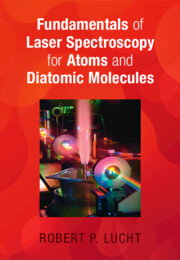Book contents
- Frontmatter
- Dedication
- Contents
- Preface
- 1 Introduction
- 2 Atomic Structure and the Quantum Mechanics of Angular Momentum
- 3 Structure of Diatomic Molecules
- 4 Quantum Mechanical Analysis of the Interaction of Laser Radiation with Electric Dipole Resonances
- 5 Quantum Mechanical Analysis of Single-Photon Electric Dipole Resonances for Diatomic Molecules
- 6 Absorption and Emission Spectroscopy
- 7 Raman Spectroscopy
- 8 Coherent Anti-Stokes Raman Scattering (CARS) Spectroscopy
- Spherical Harmonics and Radial Wavefunctions for One-Electron Atoms
- Clebsch–Gordan Coefficients, Dipole Moments, and Spontaneous Emission Coefficients for the 2p–1s Transition in Atomic Hydrogen
- Properties and Values for Selected 3j Symbols
- Properties and Values for Selected 6j Symbols (Weissbluth, 1978)
- Allowed LS Coupling Terms for Equivalent d2 Electrons
- Derivation of the Higher-Order Density Matrix Elements for Doublet and Triplet Electronic Levels
- Einstein Coefficients for Spontaneous Emission for the X2Π–A2Σ+ (0,0) Bands of OH and NO and the X3Σ−–A3Π (0,0) Band of NH
- Effect of Hyperfine Splitting on Radiative Transition Rates
- Voigt Function Values
- References
- Index
1 - Introduction
Classical Theory of Electric Dipole Radiative Interactions
Published online by Cambridge University Press: 12 December 2024
- Frontmatter
- Dedication
- Contents
- Preface
- 1 Introduction
- 2 Atomic Structure and the Quantum Mechanics of Angular Momentum
- 3 Structure of Diatomic Molecules
- 4 Quantum Mechanical Analysis of the Interaction of Laser Radiation with Electric Dipole Resonances
- 5 Quantum Mechanical Analysis of Single-Photon Electric Dipole Resonances for Diatomic Molecules
- 6 Absorption and Emission Spectroscopy
- 7 Raman Spectroscopy
- 8 Coherent Anti-Stokes Raman Scattering (CARS) Spectroscopy
- Spherical Harmonics and Radial Wavefunctions for One-Electron Atoms
- Clebsch–Gordan Coefficients, Dipole Moments, and Spontaneous Emission Coefficients for the 2p–1s Transition in Atomic Hydrogen
- Properties and Values for Selected 3j Symbols
- Properties and Values for Selected 6j Symbols (Weissbluth, 1978)
- Allowed LS Coupling Terms for Equivalent d2 Electrons
- Derivation of the Higher-Order Density Matrix Elements for Doublet and Triplet Electronic Levels
- Einstein Coefficients for Spontaneous Emission for the X2Π–A2Σ+ (0,0) Bands of OH and NO and the X3Σ−–A3Π (0,0) Band of NH
- Effect of Hyperfine Splitting on Radiative Transition Rates
- Voigt Function Values
- References
- Index
Summary
The classical theory of the interaction of light with the electron clouds of atoms and molecules will be discussed in this chapter. The discussion will begin with the interaction of a steady electric field with a collection of point charges, leading to the development of terms describing the electric dipole and quadrupole moments. The classical Lorentz model is then introduced to describe interaction of an oscillating electric field with the electron cloud of an atom, and the concepts of absorption and emission are introduced. The propagation of a light wave through a medium with electric dipoles is then discussed. Finally, the classical theory of radiation from an oscillating dipole is discussed.
- Type
- Chapter
- Information
- Publisher: Cambridge University PressPrint publication year: 2024

